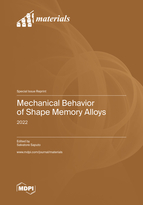Mechanical Behavior of Shape Memory Alloys: 2022
A special issue of Materials (ISSN 1996-1944). This special issue belongs to the section "Metals and Alloys".
Deadline for manuscript submissions: closed (20 November 2022) | Viewed by 29455
Special Issue Editor
Special Issue Information
Dear Colleagues,
Over recent years, interest in shape material alloys has continuously increased in several fields, such as aerospace, automotive, naval, civil, and biology. The features that make shape memory alloys attractive are the ability to recover a deformation after heating and the pseudoelastic stress–strain behavior for large deformations, as well as the biocompatibility that makes these alloys extremely interesting for the bioengineering application. To effectively use shape memory alloys, an accurate description of certain characteristics such as the critical transformation temperature and stress values is mandatory. All researchers working on shape memory materials are invited to contribute their work to this Special Issue on the “Mechanical Behavior of Shape Memory Alloys: 2021”, which will cover different topics concerning the behavior of shape memory materials from an analytical, experimental, and numerical perspective. Contributions on manufacturing processes with shape memory materials and smart structures are welcome.
The following topics will be covered in this Special Issue, among others:
- Smart materials;
- Smart structure and devices;
- Piezoelectric materials;
- Shape memory alloys (SMAs);
- Shape memory effect (SME);
- Analytical and numerical smart materials models;
- Smart materials properties and characterizations;
- Self-recovering materials;
- SMA manufacturing, testing, and design;
- SMA thermomechanical behavior;
- SMA thermoelectric behavior.
Dr. Salvatore Saputo
Guest Editor
Manuscript Submission Information
Manuscripts should be submitted online at www.mdpi.com by registering and logging in to this website. Once you are registered, click here to go to the submission form. Manuscripts can be submitted until the deadline. All submissions that pass pre-check are peer-reviewed. Accepted papers will be published continuously in the journal (as soon as accepted) and will be listed together on the special issue website. Research articles, review articles as well as short communications are invited. For planned papers, a title and short abstract (about 100 words) can be sent to the Editorial Office for announcement on this website.
Submitted manuscripts should not have been published previously, nor be under consideration for publication elsewhere (except conference proceedings papers). All manuscripts are thoroughly refereed through a single-blind peer-review process. A guide for authors and other relevant information for submission of manuscripts is available on the Instructions for Authors page. Materials is an international peer-reviewed open access semimonthly journal published by MDPI.
Please visit the Instructions for Authors page before submitting a manuscript. The Article Processing Charge (APC) for publication in this open access journal is 2600 CHF (Swiss Francs). Submitted papers should be well formatted and use good English. Authors may use MDPI's English editing service prior to publication or during author revisions.
Keywords
- shape memory alloy (SMAs)
- shape memory effect (SME)
- superelasticity
- smart materials
- constitutive models
- simulation and modeling
- smart devices







